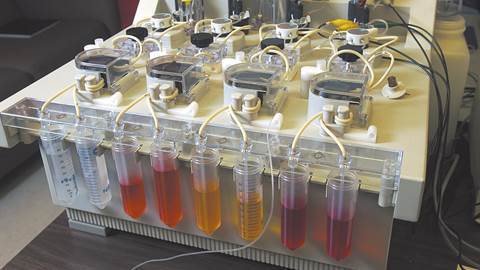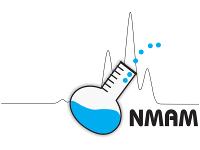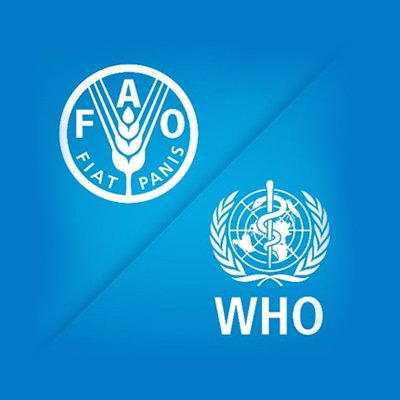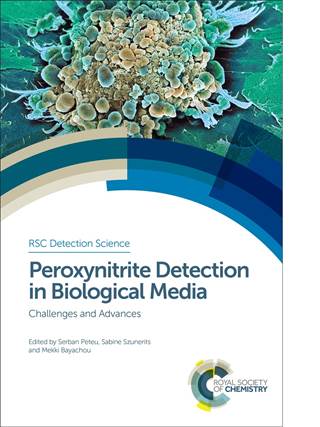Chemistry and Chemical Engineering: Analytical chemistry
Covers key library resources for chemists and chemical engineers who want to search bibliographic terms, chemical structures, chemical reactions, and physical properties or numeric data. Also includes software and collaborative tools as well as methods t
Browse new articles in analytical chemistry journals
Analytical chemistry: key resources for researchers
Featured database

- Analytical abstracts"Analytical Abstracts keeps you up to date with the most recent developments across analytical science. Covering a wide range of sources from 1980 to the present day, you can search literature records in Analytical Abstracts for specific analytes, matrices or techniques, tailor your reading to your subject area of choice or simply browse recently added articles. You can also set up personalized alerts to receive details of the latest developments in analytical science directly via email." (publisher's description)
Popular handbooks and encyclopedias
Chemical technicians' ready reference handbook, 5th edition by Jack T. Ballinger, Gershon J. Shuga, Editors
Publication Date: 2011"Now in its fifth edition, the Chemical Technicians' Ready Reference Handbook is a proven, excellent resource for anyone working in the chemical process industries. These individuals can range from laboratory technicians and process control operators to chemists, engineers, and maintenance and management personnel. This Handbook has proven to be the definitive reference on chemical safety, laboratory procedures, chemical nomenclature, basic electricity, laboratory statistics, and instrumental techniques." (publisher's description)CRC Handbook of Basic Tables for Chemical Analysis by Thomas J. Bruno; Paris D. N. Svoronos
Publication Date: 2010"Researchers in organic chemistry, chemical engineering, pharmaceutical science, forensics, and environmental science make routine use of chemical analysis, but the information these researchers need is often scattered in different sources and difficult to access. The CRC Handbook of Basic Tables for Chemical Analysis, Third Edition is a one-stop reference that presents updated data in a handy format specifically designed for use when reaching a decision point in designing an analysis or interpreting results. In response to a decade of reader input, this new edition has been expanded to include even more of the critical information scientists rely on to perform accurate analysis." (publisher's description)Handbook of Analytical Techniques by Helmut Günzler, Alex Williams, Editors
Publication Date: 2001"The two-volume handbook serves as a concise, one-stop reference source for using analytical techniques. All relevant spectroscopic, chromatographic, and electrochemical techniques are described, including chemical and biochemical sensors, as well as e. g. thermal analysis, bioanalytical, nuclear or radiochemical techniques. Special articles are devoted to general topics such as chemometrics, sampling, and sample preparation. It is the key source for problem-solving in all areas of analysis, e. g. of food, water, wastewater, air, soil, biomolecules, pharmaceuticals, or for materials characterization." (publisher's description)Handbook of Green Analytical Chemistry by Miguel de la Guardia, Salvador Garrigues, Editors
Publication Date: 2012“The Handbook of Green Analytical Chemistry provides a comprehensive overview of the present state and recent developments in green chemical analysis. A series of detailed chapters, written by international specialists in the field, discuss the fundamental principles of green analytical chemistry and present a catalogue of tools for developing environmentally friendly analytical techniques.” (publisher’s description)Encyclopedia of Analytical Chemistry by Robert A. Meyers (Editor-In-Chief)
Publication Date: 2007"The Encyclopedia of Analytical Chemistry covers all fields of chemical research: analytical, organic, physical, polymer, inorganic biomedical, environmental, pharmaceutical, industrial, petroleum, forensics, and food science. The chemistry and techniques are described as performed in the laboratory (environmental, clinical, QC, research, university), in the field, or by remote sensing. The level of detail is similar to that of a laboratory protocol and, together with the cited references, will support the analysis of complex inorganic, organic and biological structures by academic and industrial researchers. The Encyclopedia of Analytical Chemistry also facilitates preparation of procedures, protocols, and 'cookbooks' by managers and staff of laboratories." (publisher's description)Encyclopedia of Analytical Science by Paul Worsfold, Alan Townshend, Colin F. Poole, Manuel Mir, Editors-In-Chief
Publication Date: 2019"The third edition of the Encyclopedia of Analytical Science is a definitive collection of articles covering the latest technologies in application areas such as medicine, environmental science, food science and geology. Meticulously organized, clearly written and fully interdisciplinary, the Encyclopedia of Analytical Science provides foundational knowledge across the scope of modern analytical chemistry, linking fundamental topics with the latest methodologies. Articles will cover three broad areas: analytical techniques (e.g., mass spectrometry, liquid chromatography, atomic spectrometry); areas of application (e.g., forensic, environmental and clinical); and analytes (e.g., arsenic, nucleic acids and polycyclic aromatic hydrocarbons), providing a one-stop resource for analytical scientists." (publisher's description)
Sample preparation
Comprehensive Sampling and Sample Preparation by Janusz Pawliszyn, Editor-In-Chief
Publication Date: 2012"In its four volumes, this major reference work contains a complete treatment of the theory and methodology of sampling in all physical phases and the theory of sample preparation for all major extraction techniques. Fundamentals of sampling and sample preparation are reinforced through comprehensive sections dealing with Biological and Medical, Environmental and Forensic, and Food and Beverage applications." (publisher's description)Handbook of Sample Preparation by Janusz Pawliszyn, Heather L. Lord, Editors
Publication Date: 2010"Commonly viewed of as a routine task rather than as an integral component in the analytical process, sample preparation has long been undervalued as a science and underdeveloped as a technology. In an effort to reverse this trend, Handbook of Sample Preparation shows why sample preparation deserves closer scientific scrutiny, and makes a compelling case for colleges and professional laboratories to devote more resources to promote the benefits of its correct application." (publisher's description)
Instrumentation and sensors
Ewing's Analytical Instrumentation Handbook, Fourth Edition by Nelu Grinberg, Sonia Rodriguez, Editors
Publication Date: 2019"This handbook is a guide for workers in analytical chemistry who need a starting place for information about a specific instrumental technique. It gives a basic introduction to the techniques and provides leading references on the theory and methodology for an instrumental technique. This edition thoroughly expands and updates the chapters to include concepts, applications, and key references from recent literature. It also contains a new chapter on process analytical technology." (publisher's description)Instrumentation Reference Book by Walt Boyes (Editor)
Publication Date: 2009"The discipline of instrumentation has grown appreciably in recent years because of advances in sensor technology and in the interconnectivity of sensors, computers and control systems. This 4e of the Instrumentation Reference Book embraces the equipment and systems used to detect, track and store data related to physical, chemical, electrical, thermal and mechanical properties of materials, systems and operations." (publisher's description)
Other topic-focused handbooks, encyclopedias, and major reference works
Handbook of Acid-Base Indicators by R. W. Sabnis
Publication Date: 2007"While acid-base indicators continue to find new applications in an ever-widening range of scientific disciplines, there is no current book that focuses entirely on the subject, nor one that brings together the relevant advances that evolved over the last three decades. "The Handbook of Acid-Base Indicators" compiles the most up-to-date, comprehensive information on over 200 water-based and solvent-based indicators into a single source." (publisher's description)Handbook of Biosensors and Biochips, 2 Volume Set by David C. Cullen, Christopher R. Lowe, Isao Karube, Howard H. Weetall. Robert S. Marks, Editors
Publication Date: 2007"With contributions from experts in the field, the Handbook of Biosensors and Biochips provides an essential reference, underpinning many of the applications used in medical diagnostics, environmental control and pharmaceutical and food industries." (publisher's description)Handbook of Nanomaterials in Analytical Chemistry by Chaudhery Mustansar Hussain (Editor)
Publication Date: 2019"Handbook of Nanomaterials in Analytical Chemistry: Modern Trends in Analysis explores the recent advancements in a variety of analytical chemistry techniques due to nanotechnology. It also devotes several chapters to the analytical techniques that have proven useful for the analysis of nanomaterials. As conventional analytical chemistry methods become insufficient in terms of accuracy, selectivity, sensitivity, reproducibility, and speed, recent advances have opened up new horizons for chemical analysis and detection methods. Chapters are authored by experts in their respective fields and include up-to-date reference materials, such as websites of interest and suggested reading lists on the latest research." (publisher's description)Handbook of Smart Materials in Analytical Chemistry by Miguel de la Guardia, Francesc A. Esteve-Turrillas, Editors
Publication Date: 2019“A comprehensive guide to smart materials and how they are used in sample preparation, analytical processes, and applications. This two-volume handbook provides detailed information on the present state of new materials tailored for selective sample preparation and the legal frame and environmental side effects of the use of smart materials for sample preparation in analytical chemistry, as well as their use in the analytical processes and applications. It covers both methodological and applied analytical aspects, relating to the development and application of new materials for solid-phase extraction (SPE) and solid-phase microextraction (SPME), their use in the different steps and techniques of the analytical process, and their application in specific fields such as water, food, air, pharmaceuticals, clinical sciences and forensics.” (publisher’s description)Handbook of Stable Isotope Analytical Techniques by Pier A. de Groot
Publication Date: 2008"This two volume reference serves as a handbook containing a wealth of information for all isotope chemists working in a wide range of disciplines including anthropology to ecology; drug detection methodology to toxicology; nutrition to food science; and the atmospheric sciences to geochemistry." (publisher's description)Comprehensive Chemometrics by Beata Walczak, Romà Tauler, Steven Brown, Editors
Publication Date: 2020"Comprehensive Chemometrics, Second Edition features expanded and updated coverage, along with new content that covers advances in the field since the previous edition published in 2009. Subject of note include updates in the fields of multidimensional and megavariate data analysis, omics data analysis, big chemical and biochemical data analysis, data fusion and sparse methods. The book follows a similar structure to the previous edition, using the same section titles to frame articles. Many chapters from the previous edition are updated, but there are also many new chapters on the latest developments." (publisher's description)Encyclopedia of Chromatography by Cazes JACK
ISBN: 9780824705114Publication Date: 2001-06-29This practical, single-volume source collects up-to-date information on chromatographic techniques and methodologies for the solution of analytical and preparative problems applicable across a broad spectrum of disciplines including biotechnology, pharmaceuticals, environmental sciences, polymers, food additives and nutrients, pathology, toxicology, fossil fuels, and nuclear chemistry. It highlights real-world applications, easy-to-read fundamentals of problem solving and material identification methods, and detailed references.Written by over 180 esteemed international authorities and containing over 300 chapters, 2600 works cited, and 1000 drawings, equations, tables, and photographs, "The Encyclopedia of Chromatography" covers high-performance liquid, thin-layer, gas, affinity, countercurrent, supercritical fluid, gel permeation, and size exclusion chromatographies as well as capillary electrophoresis, field-flow fractionation, hyphenated techniques, and more.
(source: Nielsen Book Data)- Encyclopedia of magnetic resonance (eMagRes)Publication Date: 1990-"eMagRes captures every aspect of the interdisciplinary nature of magnetic resonance, providing all the essential information on the science, methodologies, engineering, technologies, applications and the history of magnetic resonance, whilst encompassing a whole range of techniques, including: MRI, MRS, NMR and EPR/ESR. Updated quarterly, includes over 1350 articles written by more than 1300 experts. Relevant to the Chemist, Biologist, Materials Scientist, Physicist, Radiologist, Clinician, MRI Specialist and MRI Developer." (publisher's description)
 Encyclopedia of separation science by Ian D. Wilson, Editor-in-ChiefPublication Date: 2000"The most comprehensive resource available on the theory, techniques, and applications of separation science, it covers 12 methods of separation: Affinity/Biotechnology; Centrifugation; Chromatography; Crystallization; Distillation; Electrophoresis; Extraction; Flotation; Ion exchange; Mass spectrometry; Membrane separations; and, Particle size separation. The work presents information on three levels: Overview, Methods and Instrumentation, and Practical Applications." (publisher's description)
Encyclopedia of separation science by Ian D. Wilson, Editor-in-ChiefPublication Date: 2000"The most comprehensive resource available on the theory, techniques, and applications of separation science, it covers 12 methods of separation: Affinity/Biotechnology; Centrifugation; Chromatography; Crystallization; Distillation; Electrophoresis; Extraction; Flotation; Ion exchange; Mass spectrometry; Membrane separations; and, Particle size separation. The work presents information on three levels: Overview, Methods and Instrumentation, and Practical Applications." (publisher's description)Encyclopedia of Spectroscopy and Spectrometry by John C. Lindon. George E. Tranter, David Koppenaal, Editors-In-Chief
Publication Date: 2016"This third edition of the Encyclopedia of Spectroscopy and Spectrometry provides authoritative and comprehensive coverage of all aspects of spectroscopy and closely related subjects that use the same fundamental principles, including mass spectrometry, imaging techniques and applications. It includes the history, theoretical background, details of instrumentation and technology, and current applications of the key areas of spectroscopy." (publisher's description)
Standards and guidelines
Purification of Laboratory Chemicals by W. L. F. Armarego
ISBN: 9780128054574Publication Date: 2017"Purification of Laboratory Chemicals, Eighth Edition, tabulates methods taken from literature for purifying thousands of individual commercially available chemicals. To help in applying this information, the more common processes currently used for purification in chemical laboratories and new methods are discussed. For dealing with substances not separately listed, a chapter is included setting out the usual methods for purifying specific classes of compounds." (publisher's description) Official methods of analysis of AOAC International by AOAC InternationalPublication Date: 2005"A standard resource for internationally validated and standardized analytical methods for over 100 years. The 18th edition contains over 3,000 methods, divided into more than 50 categories. Each method gives procedural directions for the specific analysis and at least one bibliographic reference. Cross-references to other related procedures are also included, when applicable." (publisher's description)
Official methods of analysis of AOAC International by AOAC InternationalPublication Date: 2005"A standard resource for internationally validated and standardized analytical methods for over 100 years. The 18th edition contains over 3,000 methods, divided into more than 50 categories. Each method gives procedural directions for the specific analysis and at least one bibliographic reference. Cross-references to other related procedures are also included, when applicable." (publisher's description) NIOSH manual of analytical methods (NMAM) by Centers for Disease Control and Prevention"NMAM is a collection of methods for sampling and analysis of contaminants in workplace air, surfaces, and in the blood and urine of workers who are occupationally exposed. These methods have been developed or adapted by NIOSH or its partners and have been evaluated according to established experimental protocols and performance criteria. NMAM also includes chapters on quality assurance, sampling, portable instrumentation, etc." (website home page)
NIOSH manual of analytical methods (NMAM) by Centers for Disease Control and Prevention"NMAM is a collection of methods for sampling and analysis of contaminants in workplace air, surfaces, and in the blood and urine of workers who are occupationally exposed. These methods have been developed or adapted by NIOSH or its partners and have been evaluated according to established experimental protocols and performance criteria. NMAM also includes chapters on quality assurance, sampling, portable instrumentation, etc." (website home page) Codex alimentarius : international food standards by Joint FAO/WHO Codex Alimentarius Commission"The Codex Alimentarius Commission, established by FAO and WHO in 1963 develops harmonised international food standards, guidelines and codes of practice to protect the health of the consumers and ensure fair trade practices in the food trade. The Commission also promotes coordination of all food standards work undertaken by international governmental and non-governmental organizations." (publisher's description)
Codex alimentarius : international food standards by Joint FAO/WHO Codex Alimentarius Commission"The Codex Alimentarius Commission, established by FAO and WHO in 1963 develops harmonised international food standards, guidelines and codes of practice to protect the health of the consumers and ensure fair trade practices in the food trade. The Commission also promotes coordination of all food standards work undertaken by international governmental and non-governmental organizations." (publisher's description)Understanding Codex by Food and Agriculture Organization (FAO) Staff
Publication Date: 2019Understanding Codex, now in its 5th edition, is a useful tool to introduce the Codex Alimentarius and its collection of international food standards to the public. The Codex Alimentarius is a collection of international food standards adopted by the Codex Alimentarius Commission that cover all the main foods as well as material used in the further processing of food. Codex provisions concern the hygienic and nutritional quality of food, including microbiological norms, food additives, pesticides and veterinary drug residues, contaminants, labelling and presentation, and methods of sampling and risk analysis. The Codex Alimentarius can safely claim to be the most important international reference point in matters concerning food quality. It plays an important role for food-related scientific research and in increasing awareness of the vital issues at stake regarding food quality, safety and public health.Analytical Measurement Terminology by Peter Bedson (Editor-In-Chief); Elizabeth Prichard
Publication Date: 2001"The variety of complex terms used in the Quality Assurance aspect of analytical measurement can be the cause of considerable confusion. This unique handbook explains the most widely-used terminology in language that is readily understood, and attempts to place each term in context. Explanations of terms are always in line with the "official definition", often developed by international committees." (publisher's description)
Review series
 Comprehensive analytical chemistry by Cecil L. Wilson and David W. Wilson, EditorsPublication Date: 1959-"Presents the basic principles, recent developments and important applications of analytical chemistry. Discusses in depth topics regarding experimental phenomena, major advances, experimental approaches, essential instrumental methods, theoretical strategies and important applications within the field." (publisher's description)
Comprehensive analytical chemistry by Cecil L. Wilson and David W. Wilson, EditorsPublication Date: 1959-"Presents the basic principles, recent developments and important applications of analytical chemistry. Discusses in depth topics regarding experimental phenomena, major advances, experimental approaches, essential instrumental methods, theoretical strategies and important applications within the field." (publisher's description)
- RSC detection science series
 "Providing a comprehensive look at the state of the art in detection technologies and materials used in the development of diagnostics for clinical, medicinal, and environmental applications, the books in this Series are a valuable reference for graduate students and professional researchers across academia and industry. Emphasizing the detection of chemicals and biochemical species in a quantitative fashion, the series will also be beneficial to researchers because of the detailed nature of these titles.
"Providing a comprehensive look at the state of the art in detection technologies and materials used in the development of diagnostics for clinical, medicinal, and environmental applications, the books in this Series are a valuable reference for graduate students and professional researchers across academia and industry. Emphasizing the detection of chemicals and biochemical species in a quantitative fashion, the series will also be beneficial to researchers because of the detailed nature of these titles.
Treatise on analytical chemistry by I. M. Kolthoff and Philip J. Elving, Editors
Publication Date: 1978-"Part I deals with the general fundamentals of analytical chemistry. Part II deals with the analytical chemistry of organic and inorganic compounds in more specific terms. Part III concerns analytical chemistry in industry." (publisher's description)
Foundational texts
Analytical Chemistry by Gary D. Christian; Purnendu K. Dasgupta; Kevin A. Schug
Publication Date: 2013"With the 7th Edition of Analytical Chemistry focuses on more in-depth coverage of the principles and techniques of quantitative analysis and instrumental analysis. The goal of the text is to provide a foundation of the analytical process, tools, and computational methods and resources, and to illustrate with problems that bring realism to the practice and importance of analytical chemistry. It is designed for undergraduate college students majoring in chemistry and in fields related to chemistry." (publisher's description)Basics of Analytical Chemistry and Chemical Equilibria by Brian M. Tissue
Publication Date: 2013"Written for undergraduate students who have completed a basic course in general chemistry, the Basics of Analytical Chemistry and Chemical Equilibria is clearly written and easy to follow, with plenty of examples to help readers better understand both concepts and applications. This text enables students to fully grasp and apply the core concepts of analytical chemistry and aqueous chemical equilibria. The text also enables readers to master common instrumental methods to perform a broad range of quantitative analyses." (publisher's description)Chemometrics by Matthias Otto
Publication Date: 2016"Chemometrics: Statistics and Computer Application in Analytical Chemistry, 3rd edition, is an introductory textbook and ready reference covers all pertinent topics, from basic statistics via modeling and databases right up to the latest regulatory issues. The author introduces the statistical-mathematical evaluation of chemical measurements, especially analytical ones, going on to provide a modern approach to signal processing, designing and optimizing experiments, pattern recognition and classification, as well as modeling simple and nonlinear relationships. Analytical databases are equally covered as are applications of multiway analysis, artificial intelligence, fuzzy theory, neural networks, and genetic algorithms. The new edition covers recent developments such as orthogonal signal correction and new data exchange formats, tree based classification and regression, independent component analysis, ensemble methods and neuro-fuzzy systems. It retains worked examples, questions and problems, additional information and brief explanations in the margin." (publisher's description)Fundamentals of Analytical Chemistry by Douglas A. Skoog; Stanley R. Crouch; F. James Holler; Donald M. West
Publication Date: 2003“Fundamentals of Analytical Chemistry, 8th edition, is known for its readability combined with a systematic, rigorous approach that characterizes this classic text. Extensive coverage of the principles and practices of quantitative chemistry ensures suitability for chemistry majors. This text includes applications used throughout industry, medicine, and all the sciences.” (publisher’s description)Practical Instrumental Analysis by Sergio Petrozzi; Simon Goudie
Publication Date: 2012"This practical book in instrumental analytics conveys an overview of important methods of analysis and enables the reader to realistically learn the (principally technology-independent) working techniques the analytical chemist uses to develop methods and conduct validation." (publisher's description)Principles of Instrumental Analysis by Douglas A. Skoog; F. Holler; Stanley Crouch
Publication Date: 2018"Principles of Instrumental Analysis, 7th edition, places an emphasis on operating principles of each type of instrument, its optimal area of application, its sensitivity, its precision, and its limitations. You'll also learn about elementary analog and digital electronics, computers, and the treatment of analytical data. The book companion website has supplemental tutorials on instrumental methods, Excel files of data analysis and simulations of analytical techniques to help you visualize important concepts in this course, and selected papers from the chemical literature to stimulate interest and provide background information for study.” (publisher’s description)Vogel's Quantitative Chemical Analysis by Arthur I. Vogel; J. D. Barnes; R. C. Denney; J. Mendham; M. J. K. Thomas
Publication Date: 2000"Dr Vogel's classic introduction to analytical methods has provided generations of chemists worldwide with a basis for teaching, learning and applying analytical chemistry. This 60th anniversary edition - the first for a decade - reflects major changes in the subject. Analysts need to understand the concepts behind methods and Vogel's Quantitative Chemical Analysis provides clear introductions to all the key analytical methods including those involving advanced computerized equipment available in many analytical laboratories. The editors have built further on the work of Dr Vogel, modernizing the approach while retaining the analytical concepts and ideas which were built into the original work. This new edition has been extensively revised to take into account developments in instrumental procedures and coupled techniques while maintaining the book's focus on quantitative chemical and problem-specific analyses. With excellent cross-referencing this book provides a wealth of examples and tables of data." (publisher's description)
- Key library links
- Reference shelf / softwareToggle Dropdown
- Article & patent databasesToggle Dropdown
- Syntheses & reactionsToggle Dropdown
- Data & propertiesToggle Dropdown
- Lab safetyToggle Dropdown
- Subjects: analytical, physical & theoretical chemistry resources
- Subjects: biological, inorganic & organic chemistry resourcesToggle Dropdown
- Subjects: energy, environment, & materials chemistry resourcesToggle Dropdown
- Last Updated: Dec 20, 2024 3:59 PM
- URL: https://guides.library.stanford.edu/chem
- Print Page
Subjects: Chemical engineering, Chemistry, Science and engineering
Tags: chemical engineering, chemistry, Science